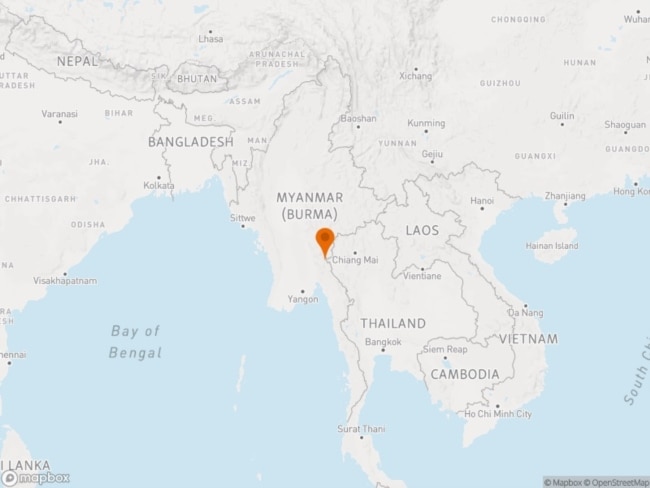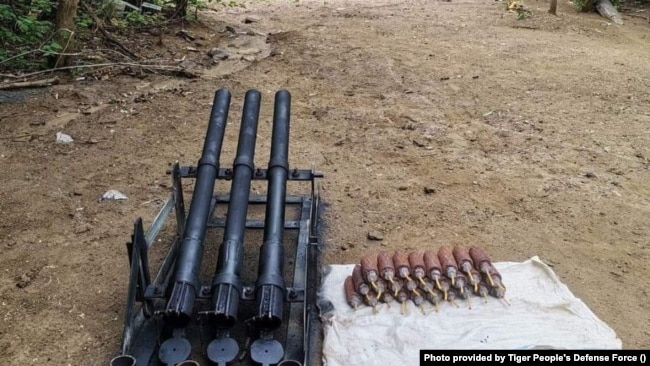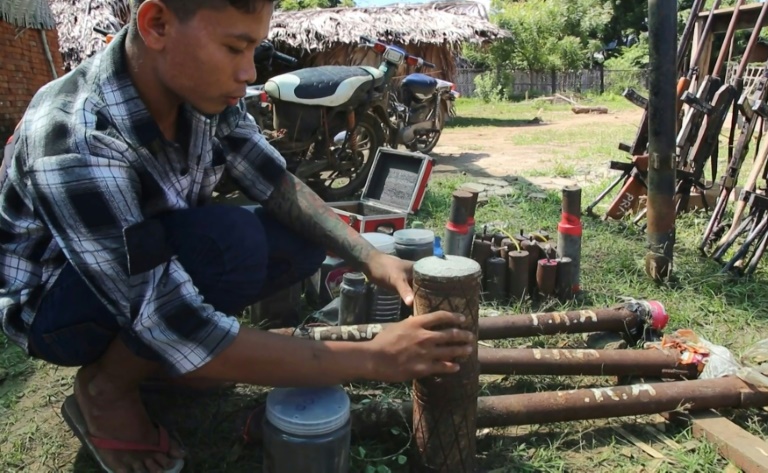Myanmar rebels risk life and limb in DIY weapons factories
Pale – Under an awning in a bamboo thicket in northern Myanmar, an anti-coup fighter following instructions from YouTube welds scavenged steel into crude mortar rounds and shells to be fired at junta troops.
Almost two years after seizing power, the military has been unable to crush local militias that have sprung up to fight the putsch with hit-and-run tactics.
In turn, these People’s Defence Forces (PDF) remain massively outgunned by the military’s artillery strikes, Chinese and Russian-made jets and Israeli-patterned rifles.
Captured weapons and expensive purchases on the black market have provided patchy boosts to PDF firepower, analysts say, but many militias have turned to risky trial-and-error operations to churn out their own rockets, mines and mortars.
“We just learn how to build weapons from the internet or YouTube,” said Nay Min, an anti-coup fighter from the northern Sagaing region.
“We search how to cook saltpetre (potassium nitrate), how to combine it to get gunpowder, how to build rifles. We haven’t received any training,” he told AFP.
Those with engineering or mechanical backgrounds, like his comrade Nay Myo Win, experiment and come up with prototypes or copies of captured weapons, he said.
Blowtorches in hand, they sweat for hours in makeshift workshops powered by generators that are frequent targets of junta raids.
Nay Myo Win mixes saltpetre to make the gunpowder needed to fire mortar shells filled with lead and scrap metal that he claims have a range of just over two kilometres (1.2 miles).
– Crude armaments –
Laid out on a tarpaulin ahead of a mission in October, the mortars are unimpressive — little more than construction pipes welded to bipods.
The shells require two charges to detonate — one to fire the shell and the other to explode on impact — a method first used at the beginning of the 20th century.
But the damage is substantial, Nay Min said — “around 15 feet from the target it will hit people and they will die or be wounded”.
One batch of shells was made from a telecoms tower owned by a firm close to the military, which was sabotaged by PDF fighters some months ago.
“We just wanted to destroy their business,” Nay Min added.
“But, after we had started making homemade weapons … we needed more stainless steel and we thought of the tower.”
Nay Min’s group is one of dozens of PDF militias in Sagaing making their own weapons in a bid to turn the tide in the fighting.
Many upload footage of successful tests of mortars, rockets or mines to social media, with joyous shouts accompanying each loud bang.
But the work can be deadly.
“It’s more than dangerous,” said Bo Shaung, an anti-coup fighter and rocket maker from another group operating in Sagaing.
“When we cook gunpowder, if we add too much saltpetre, it’s dangerous. If we add too little, it’s also dangerous.”
One video obtained by AFP shows a new mortar being tested. The shell explodes in the barrel, killing the fighter who had just loaded it.
Thu Ya, another anti-coup fighter, said he lost his sight six months ago when the explosive he was handling went off too soon.
“I got injuries on my hands and feet which have recovered now but I… still have blurry vision,” he said.
In the absence of machines like lathes and voltage regulators, each shell is made by hand.
And for all the risk that comes with producing them, the homemade munitions are often more bark than bite.
– ‘Drain on morale’ –
Once a target has been selected, preparing ammunition for an attack can take up to 10 days, Nay Min said.
His group relies on information from locals to gauge troop positions.
To guide their fire they have little more than Google Maps to measure the distance from the target.
“We normally attack them in our own areas and we all know the locations and distance,” he said, insisting that most attacks were accurate.
Assessing the effectiveness of these weapons is “extremely difficult” in the absence of impartial reporting from the field, said Bangkok-based security analyst Anthony Davis.
Both sides regularly inflate or play down their casualty figures, analysts say.
But Davis said the spread of locally made mortars and rockets “indicates that these systems are far from simply window-dressing”.
“They inflict real casualties but perhaps as importantly are a constant drain on the morale of often isolated army units on the receiving end.”
The junta has labelled all PDF groups as “terrorists”. It blames anti-coup fighters for the deaths of more than 4,000 civilians.
Nay Min sees his group’s fight as justified.
“We are satisfied with what we have done,” he said.
But “we need everything. Especially we need weapon."
Myanmar: The DIY weapons factories
arming anti-junta fighters
Militias fighting the military junta in Myanmar have turned to making their own DIY weapons, including rockets and mortars, as they take on a much more heavily armed adversary. But constructing the weapons is dangerous work, with accidents, particularly during testing, claiming the lives of militia members.
Anti-Junta Forces in Myanmar Rely on
Homemade Weapons

Opposition People’s Defense Forces in Myanmar are battling the ruling junta’s military with locally produced weapons, members of the PDF told VOA in recent weeks.
The PDF members, mostly students and farmers with no previous weapons manufacturing experience, said they figured out how to make the weapons from YouTube and from each other.
Most opposition troops are said to rely on these improvised weapons.
Some opposition armed groups in central Myanmar and in Kayah state, along the country’s eastern border with Thailand, have been producing and using handmade weapons, including rocket launchers, inflicting heavy casualties on junta forces.
The Tiger People’s Defense Force in Sagaing region’s Pale township has produced 15 rockets with a range of around three miles. Initially the group produced rudimentary rifles, bombs and mines, then moved to producing rocket launchers and ammunition within six months.
“We made 100 single-shot rifles and shared them with other groups in Sagaing region and produced 300 rounds for rocket launchers. All of those weapons are being used in battle,” said Bo Than Chaung, head of the Tiger People’s Defense Force information and weapons production team.
Another resistance unit, the Karenni Generation Z, active in Kayah and southern Shan state, has been producing 130 mm, 70 mm and 55 mm mortars since March. Kalay Bo, the unit’s spokesperson said it costs between $50 and $80 to make a mortar.
Karenni Generation Z can produce 20 rounds for 130 mm mortars per day. However, it must change locations whenever the junta finds out where it is operating, and it faces raw material and, most importantly, financial issues.

“At first, we were able to produce homemade hunting rifles to fight the military. However, we could not resist with these guns when the junta forces used automatic weapons, long-range artillery, jets and helicopters. That’s why we developed more advanced weapons to fight the military,” Kalay Bo said.
Armed resistance movements erupted across Myanmar shortly after the military cracked down on peaceful protests of last year’s military coup. Since then, the armed People’s Defense Forces have emerged. However, not all the groups are working together under a single command. The opposition National Unity Government has said 257 battalions have been established under the command of the NUG defense ministry and more than 500 PDFs are affiliated with the ministry.
Some PDFs are based in areas in Kachin, Kayah and Karen states in the east and Chin state in the west that are under the control of armed ethnic organizations that have been fighting for autonomy for years. Those units are receiving arms support from the Karen National Union, Kachin Independence Organization, and the Arakan Army – themselves ethnic organizations – as well as the NUG.
However, obtaining weapons for fighters in central Myanmar is difficult because of transportation difficulties and lack of funding. According to the resistance chapters, it costs at least $3,000 for an automatic machine gun on the black market. Because of the lack of weapons and insufficient funds, opposition groups have turned to producing weapons themselves.
One group, the Anti-Dictatorship People’s Revolutionary Army, or DPRA, with nearly 1,000 fighters, which operates mainly in Sagaing but also has launched guerilla attacks in the cities of Yangon and Mandalay, learned the technique for producing rockets from its ally, the Kani Guerrilla Force in Sagaing. Depending on the availability of raw materials, the DPRA said it manufactures 20 rocket launchers, 30 60 mm mortars, 20 roadside bombs and 30 8 mm rifles a month.
“We receive 10 million kyats [$5,000] a month from public donations and most of it is used for weapons production,” Linn Nway, a senior member of the organization, told VOA.
The DPRA estimates production costs at $175 for a roadside bomb, $35 for each 60 mm mortar and 8 mm rifle round, $75 for a rocket with a range of between three and five miles. “It takes three months to produce a rocket,” Linn Nway said.
Some small opposition groups made up of around 50 members are incapable of combat with the junta forces because of a shortage of weapons and manpower. The groups depend heavily on their production of mines for guerrilla warfare against military convoys, bases, banks and buildings.
“Although we cannot fight with the junta forces, they are afraid of entering into the villages. They were ambushed by our group, which inflicted heavy causalities because of landmines we planted,” said Bi Lone, a leader of the Black Wolf Defense Force in Sagaing’s Monywa township.

Most of the PDF-produced weapons are rudimentary and insufficient to defeat the well-armed junta forces.
Many groups can only produce single-shot guns that can only be loaded with one bullet.
“Each time we shoot, we have to insert another bullet to shoot again,” Bo Than Chaung said.
Opposition groups say the lack of military-grade raw materials and of arms-making experience has cost lives and caused injuries and loss of materials when manufacturing weapons. In October, some members of Black Wolf Defense Force were seriously injured and a large quantity of raw materials, plus fighters’ property, including uniforms were destroyed in an explosion while making explosive devices, Bi Lone said.
Another issue facing the opposition groups is obtaining raw materials, such as iron pipes, lead, and gunpowder, as the military regime has restricted the transportation of metal, including iron and steel, into Sagaing. Goods coming into Sagaing are subject to strict inspections.
“We can manage to get iron, mostly we face shortage of gunpowder imported from India and the Thai border. We cannot make homemade bombs without it,” said Lin Nway. Under these circumstances, the price of raw materials has tripled, and it costs more than $150 for 35 grams of gunpowder.
Opposition groups say only 10% of their troops can be armed with commercially produced weapons, and the rest rely heavily on locally produced weapons. The groups are heavily dependent on public donations and selling their belongings to raise funds for weapons production, however, production can fulfill less than 50% of requirements. Under these circumstances, the opposition forces all say a lack of financial support is the biggest problem.
“We need at least 10 million kyats [$5,000] per month, however, the donation we normally receive is around 5 million kyats [$2,500],” said Bo Than Chaung. The group is working under the NUG but has not received any support so far.
“I hope, one day we will get weapons from NUG,” he added.
On July 9, the NUG’s defense ministry publicly shared its spending for military affairs. As of May, of the $44 million in military spending, about 63% went for weapons, ammunition and military operations and 22% went for weapons production. The NUG has said it needs at least $10 million a month to support the fighting forces.

No comments:
Post a Comment